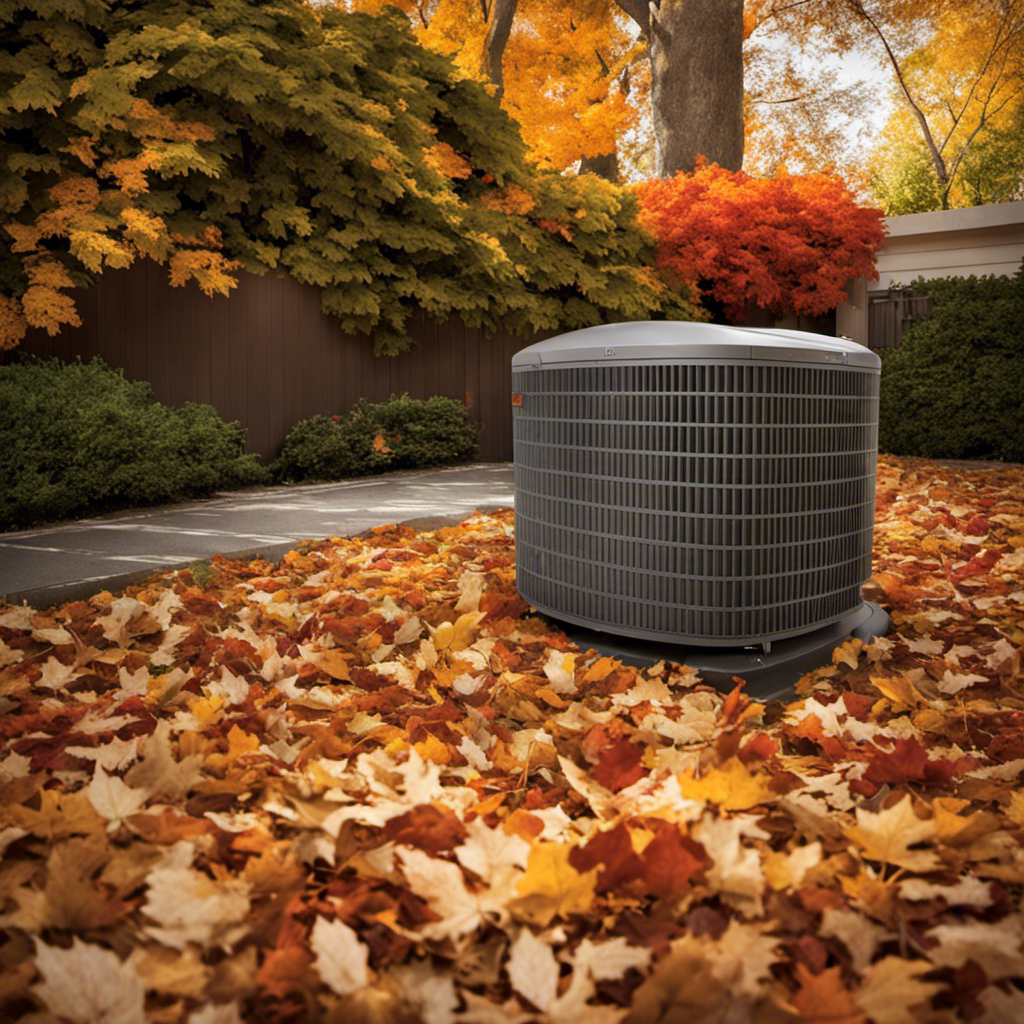As the temperature begins to drop and the leaves change color, homeowners often find themselves contemplating whether to cover their AC units in the fall. This article examines the benefits and potential drawbacks of covering your AC unit, along with factors to consider before making a decision.
Additionally, alternative options to covering the unit will be explored, as well as tips for properly covering it if you choose to do so.
Stay informed and make an informed choice for your home’s cooling system.
Key Takeaways
- Covering your AC unit in the fall can provide protection against debris and weather elements, preventing potential damage and increasing longevity of the unit.
- However, there are potential drawbacks to consider, such as restricted airflow, increased energy consumption, and the buildup of dirt and debris causing system breakdowns.
- Before deciding whether to cover your AC unit, factors to consider include maintenance requirements, proper installation and secure fastening of the cover, regular inspections and cleaning, and the specific needs of the AC unit.
- Alternatives to covering your AC unit in the fall include investing in energy-efficient cooling options, scheduling regular maintenance, clearing the area around the unit of debris, and ensuring proper insulation and checking for leaks or blockages.
Benefits of Covering Your AC Unit in the Fall
One of the key benefits of covering your AC unit in the fall is the protection it provides against debris and weather elements. By using a cover, you can prevent leaves, twigs, and other outdoor debris from entering and potentially damaging the unit. This protection is essential for maintaining the efficiency and performance of your AC unit.
Moreover, covering your AC unit in the fall also helps to protect it from harsh weather conditions such as rain, snow, and strong winds. These weather elements can cause corrosion, rust, and other forms of damage, leading to costly repairs or even the need for a replacement unit. Therefore, by investing in a cover for your AC unit, you can ensure its longevity and save on repair and replacement costs.
Additionally, covering your AC unit also contributes to energy efficiency benefits. By preventing debris from entering the unit, you can maintain proper airflow and prevent clogging, which ultimately improves the unit’s efficiency and reduces energy consumption.
Potential DrawbACks of Covering Your AC Unit in the Fall
While there are several benefits to covering your AC unit in the fall, it is important to consider the potential drawbacks as well.
One potential drawback is the potential damage that can occur when covering your AC unit. If the cover is not properly secured or if it becomes damaged, it can cause moisture to accumulate inside the unit, leading to corrosion and electrical issues.
Additionally, covering your AC unit can restrict airflow, which is essential for optimal performance. Restricted airflow can result in reduced cooling efficiency and increased energy consumption. It can also lead to the buildup of dirt and debris, which can clog the unit and cause it to work harder, potentially leading to system breakdowns.
Therefore, it is important to carefully weigh the potential drawbacks before deciding whether or not to cover your AC unit in the fall.
FACtors to Consider Before Deciding Whether to Cover Your AC Unit
Before making a decision on whether to cover your AC unit in the fall, it is essential to carefully consider the factors involved.
There are both pros and cons to covering your AC unit during the colder months.
One factor to consider is the maintenance requirements of your AC unit. If you choose to cover it, you must ensure that the cover is properly installed and securely fastened to prevent any damage to the unit.
Additionally, regular inspections and cleaning are necessary to ensure that there is no buildup of debris or moisture trapped inside the cover, which could lead to mold growth or other issues.
On the other hand, not covering your AC unit allows for better airflow and ventilation, reducing the risk of trapped moisture and potential damage.
Ultimately, it is important to weigh the pros and cons and consider your specific AC unit’s needs before deciding whether to cover it in the fall.
Alternatives to Covering Your AC Unit in the Fall
Several alternative options exist for protecting your AC unit in the fall without using a cover.
One option is to invest in energy efficient cooling options such as a programmable thermostat or a high-efficiency AC unit. These options not only provide better temperature control but also help reduce energy consumption and lower utility bills.
Another alternative is to schedule regular maintenance for your AC unit in the fall. This includes cleaning or replacing air filters, checking for any leaks or blockages, and ensuring proper insulation.
Additionally, it is important to keep the area around the AC unit clear of debris and vegetation to allow for proper airflow.
Tips for Properly Covering Your AC Unit if You Choose to Do so
To ensure the longevity and proper functioning of your AC unit during the fall season, it is important to know how to properly cover it if you choose to do so. Here are some tips for insulation, maintenance, and protection of your AC unit.
Firstly, before covering your AC unit, make sure to clean it thoroughly. Remove any debris or leaves that may have accumulated on or around the unit. This will prevent any potential obstructions and allow for proper airflow.
Next, choose a high-quality cover that is specifically designed for AC units. It should be waterproof and breathable to prevent moisture buildup while still providing insulation.
When covering the unit, make sure it is securely fastened to prevent it from being blown away by strong winds. This will also protect it from potential damage caused by falling branches or debris.
Remember, not covering your AC unit in the fall can expose it to various risks. Moisture can accumulate inside the unit, leading to corrosion and damage to sensitive components. Leaves and debris can also clog the system, hindering its performance.
Frequently Asked Questions
How Often Should I Cover My AC Unit in the Fall?
Covering frequency for an AC unit in the fall depends on various factors such as climate and location. However, covering the unit can provide benefits like protecting it from debris, reducing potential damage, and improving overall efficiency.
Will Covering My AC Unit in the Fall Affect Its Performance?
Covering your AC unit in the fall can positively impact its performance and longevity. It helps protect the unit from debris, leaves, and ice, preventing potential damage and reducing the need for extensive AC unit maintenance.
Can Covering My AC Unit in the Fall Lead to Mold or Mildew Growth?
Covering your AC unit in the fall can help prevent moisture buildup and debris accumulation, reducing the risk of mold and mildew growth. This maintenance measure ensures optimal performance and longevity of your unit.
Should I Cover My AC Unit if It’s Located Under a Covered Patio or in a Garage?
When considering AC unit maintenance and protection, it is important to assess factors such as the location of the unit, such as being under a covered patio or in a garage, to determine whether covering it in the fall is necessary.
What Are the Potential Risks of Not Covering My AC Unit in the Fall?
Not covering your AC unit in the fall can expose it to potential risks. Leaves and debris can accumulate and clog the unit, leading to reduced efficiency and potential damage to the components.


